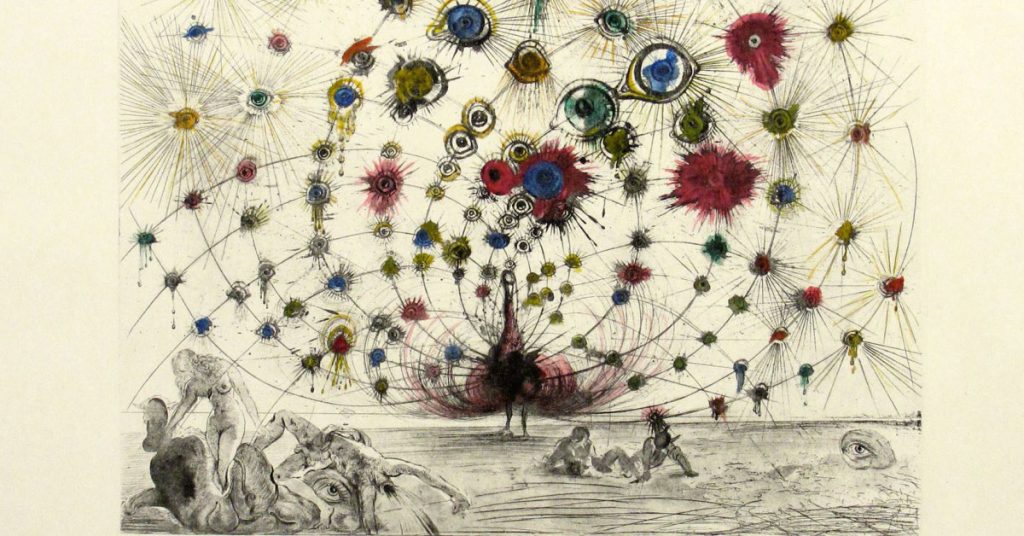Salvador Dali (1904-1989) is a solo exhibition of the Spanish surrealist at ACA Galleries in Chelsea, Manhattan Tuesday-Saturday, from January 10 through March 9, 2019.
The exhibition opens with a reception on Thursday, January 10, 2019 from 7-9pm.
Salvador Dali, the exhibition
The exhibition is of etchings, tapestries and drawings from the Argillet Collection.
Pierre Argillet (1910-2001) was Dali’s publisher and a collaborator over 50 years of friendship. They would drink and talk and then Dali would draw. Because of that personal relationship, it is one of the best Dali collections.
Argus in Color
The etching Argus in Color, 1963 (22×30 in) is a fascinating image. The peacock is an ancient symbol of spirituality and royalty. The circles in its tail feathers are often interpreted as eyes.
The way Dali drew the interlocking shafts of feathers suggests a magnetic or energy field, very much like those who see auras (the human energy field) have reported.
Making the traditional reference, Dali draws the circles in the peacock’s feathers as eyes that are radiating like stars. But he also adds male and female nudes, a woman stepping out of a vulva next to a man who is completely collapsed. He seems to suggest that transcendence comes out of the union of sex.
The drawing gives you the feeling of what we call in Spanish, “polvo,” meaning dust or the warm afterglow you feel after a good round of making love.
Dali has taken a straightforward image and filled it with transcendental meaning.
Individual Bullfight, ed. 2/6
This Aubusson tapestry captures the passion and violence of a Spanish bullfight.
Dali offers the silhouette of the matador’s hat and his flying cape to set the stage for the blooded and dying bull. You can almost smell the blood.
Aubusson is the legacy of a group of 17th century French artists who figured out how to weave three-dimensional patterns into rugs. They are still woven by hand in the village of Aubusson about four hours drive outside Paris.
The tapestry was created by Aubusson master artisan Raymond Picaud.
This is a very rare and evocative piece.
Salvador Dali, the artist
The Spaniard is one of the world’s most famous modern artists. He captured the surreal world of dreams probably better than anyone ever has.
Dali’s molten clocks, distorted creatures and landscapes that are actually figures leave a puzzled impression like you just woke from a dream and are trying to remember what it means before the memory fades.
Dali’s most famous painting, The Persistence of Memory, is in the permanent collection at MoMA. You can see it in the Collection Galeries on Floor 5.
He was a natural marketer who built a persona around behaving oddly. Even Dali’s upturned moustache and bulging eyes look like a character you might meet in a dream.
In the 1940s and early 1950s, during and after World War II, Dali moved to New York. His move was part of the tectonic shift of the art world from Paris to New York City.
The main museums of Dali’s work are the Dali Museum in Figueres, Spain and The Dali Museum in St. Petersburg, Florida.
ACA Galleries
529 West 20th St, New York, NY 10011
(between Tenth & Eleventh Ave)
Chelsea, Manhattan
Tuesday-Saturday: 11am-6pm

